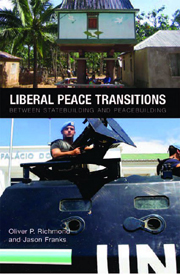Book contents
- Frontmatter
- Contents
- Acknowledgements
- List of Acronyms
- Introduction: a Framework to Assess Liberal Peace Transitions
- 1 Cambodia: Liberal Hubris and Virtual Peace
- 2 Bosnia: Between Partition and Pluralism
- 3 Liberal Peace in East Timor: the Emperors' New Clothes?
- 4 Co-opting the Liberal Peace: Untying the Gordian Knot in Kosovo
- 5 Building/Rejecting the Liberal Peace: State Consolidation and Liberal Failure in the Middle East
- Conclusion: Evaluating the Achievements of the Liberal Peace and Revitalising a Virtual Peace
- Select Bibliography
- Index
1 - Cambodia: Liberal Hubris and Virtual Peace
Published online by Cambridge University Press: 12 September 2012
- Frontmatter
- Contents
- Acknowledgements
- List of Acronyms
- Introduction: a Framework to Assess Liberal Peace Transitions
- 1 Cambodia: Liberal Hubris and Virtual Peace
- 2 Bosnia: Between Partition and Pluralism
- 3 Liberal Peace in East Timor: the Emperors' New Clothes?
- 4 Co-opting the Liberal Peace: Untying the Gordian Knot in Kosovo
- 5 Building/Rejecting the Liberal Peace: State Consolidation and Liberal Failure in the Middle East
- Conclusion: Evaluating the Achievements of the Liberal Peace and Revitalising a Virtual Peace
- Select Bibliography
- Index
Summary
What is, is, what is not, is not. The Tao is made because we walk it, things become what they are called.
Chuang TzuIntroduction
In 1993 there seemed to be an early post-Cold War triumph for the United Nations, and for the liberal peace. Following the proclamation of the Cambodian constitution and the creation of the new government of Cambodia, the United Nations Security Council declared the successful completion of the mandate of the United Nations Transitional Authority in Cambodia (UNTAC) and pulled out. This heavily publicised (and much criticised) withdrawal was hailed as a great achievement for the UN and the ‘new world order,’ as it seemingly replaced a particularly brutal intrastate conflict with the concept of liberal peace. However, as this chapter argues, the liberal peacebuilding project in Cambodia has been far from successful and has created little more than a virtual peace. Leaving aside the ontological problem of whether the liberal peace is at all viable, or whether its export through a weak peacebuilding consensus is possible, why is it that the liberal peacebuilding project in Cambodia has failed after so many years to move beyond the virtual? The liberal peace seems mainly to exist in the minds of the international elites who are attempting to steer its reform and development and is at best incompatible with the indigenous Cambodian political, social, cultural and economic structures. Applying the liberal peace to Cambodia is analogous to using a square peg for a round hole.
- Type
- Chapter
- Information
- Liberal Peace TransitionsBetween Statebuilding and Peacebuilding, pp. 18 - 53Publisher: Edinburgh University PressPrint publication year: 2009

